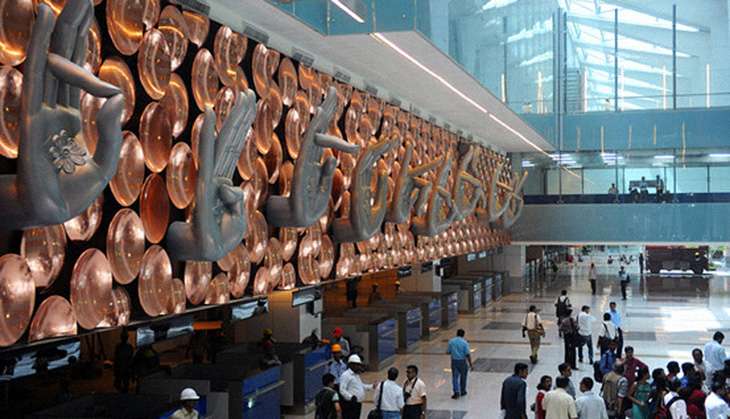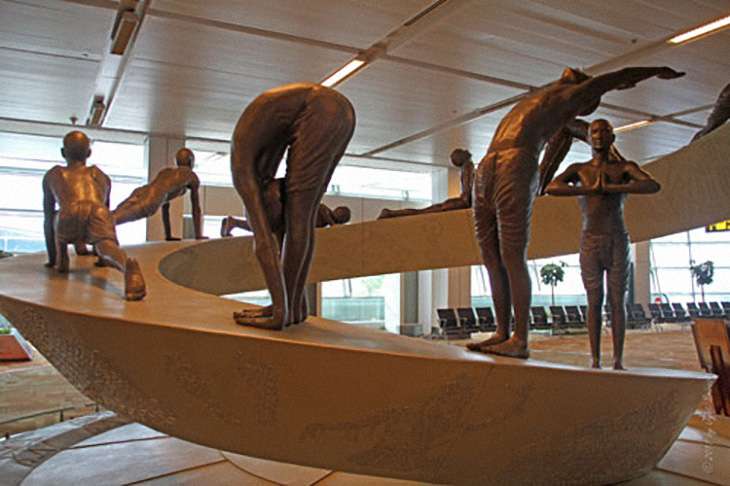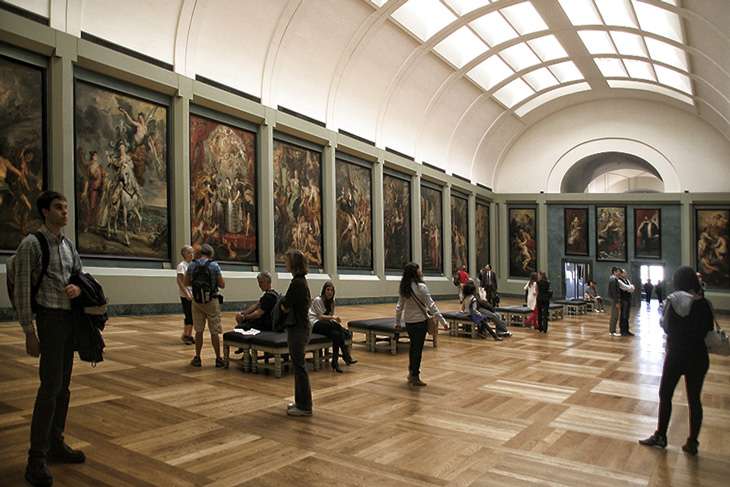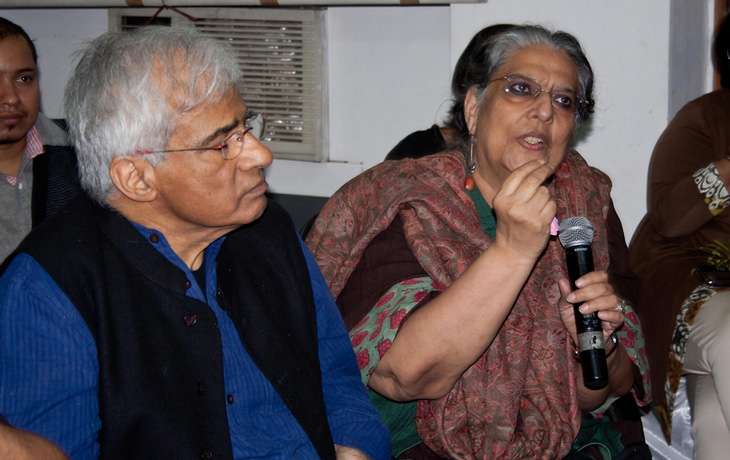How Vivan Sundaram and Company Killed Indian Art

If your mind allows you to take your attention off from your own temporary glory of walking along the carpeted corridors of the international airports in Delhi or Mumbai, within that transitory zone you would come across the works of art done by Indian artists carefully culled and artistically displayed there in conspicuous and inconspicuous walls and corners.

However, I haven't yet seen people taking selfies before these works of art. Instead, they go to the generic yet spectacular gestures and physical movements captured in fibreglass sculptures and take selfies.
Let me tell you, this is not done by uninitiated folks alone. I have seen reputed gallerists posing before these sculptural atrocities, taking selfies and posting them instantly in their social media pages to tell the world that they are on the move!
Also read - Banksy just reminded us that Steve Jobs was the son of a Syrian immigrant
I do not take pictures in airports. However, these works of art displayed in various joints at the airports, for me, underline the presence of the invisible middlemen/women who have 'arranged' the procurement of these works. I have felt this invisible presence of the so called art consultants when I walk through the hotel lobbies and hospital aisles. I see well known names but sub standard works. Something has gone terribly wrong in our country.
What's gone wrong with Indian art?
It is said each public building should invest seven per cent of its total cost in procuring art as a part of promoting culture in the country. And they do spend this money on art. But the kind of art that we happen to come across in the public buildings makes our skin cringe in shame. But there is a huge danger than the general embarrassment caused by these works of art.
The people from abroad, with a cultural outlook, a museum culture that has shaped their sensibilities etc., upon seeing these works of art in the airports and public buildings, could think that this is the kind of art that we still produce. My readers must remember that it was a couple of months back a British art critic had rubbished Bhupen Khakar's show in Tate saying that Khakar's paintings were as good as the mediocre artists in London in 1980s.
Also read - Meet Bijayanand Biswal: The Ticket Examiner who paints railway stations
The foreigners who see Indian art in public buildings and airports would definitely have the same feeling. They could think that we Indians are still producing some kind of art that they had already discarded decades back.

What has gone wrong with our art? Is it because India lacks in good art; I mean good paintings, sculptures, prints, photography and so on? Our Prime Minister recently had initiated a 'Skill India' campaign. This campaign comes from the fact that as Indians we have been lacking in the required skill sets to be at par with the world.
The illusionary jump in the job market, especially in the IT field, is purely based on supplementary skills or auxiliary skills than the primary skills. We are always the supporting staff. Hence, even if I do not agree with the political policies of the present Prime Minister of India, I would definitely say that skill development in India is one of the core areas that needs urgent attention, including in the field of fine arts.
Knowingly or unknowingly the Prime Minister has touched upon the crucial problem that the British education had created in India and later on by careful strategizing of the western cultural industry aided by their handpicked Indian artists and intelligentsia in order finish off Indian skills.
Without understanding the kind of trap that they have been walking into, these artists and intelligentsia worked as stooges for the western cultural interests and almost killed the fine arts skills of India.
The western sabotage of Indian art
When Lord Macaulay introduced the educational policy for the colonial subjects in India in 19th century, his aim was clear. He knew for sure that it was difficult to break the backbone of Indian culture by destroying its innate skills and concepts.
The best way was not only to create 'Indian looking and British thinking' subjects to keep accounts and audits of the Empire in India and serve it ideologically through education, but also to destroy the confidence of the Indians by making them feel that anything that was native including language was inferior to whatever English was.
More than creating clerks and administrative staff (the way call centres are created today by the imperial corporate houses), the British were successful in creating Indians who felt themselves ugly and less skilled compared to the technical efficiency that the British people displayed.
Our art schools were conceived as technical education centres where draftsmen were trained to work for various British departments. Students from the traditional artisanal families were culled and mentally castrated by inducing them with the western scientific skills in drawing as well as in conceptualising.
Also read - 25 artists. 100 shipping containers. 1 amazing idea. Delhi St+Art festival is back
The traditional skills which had been polished in various schools and gharanas since the Mughal period and their hybrid varieties both in the fiefdoms and bazaars were in fact creating a larger climate for the proliferation of visual art which the British had carefully killed. By making our art and art practices inferior to the western art, they created a new history in which Indian artists always looked derivatives of the western masters.

The re-emergence of an Indian artistic identity
It took many years for our artists aided by the nationalistic thoughts and later by individualistic pursuits in order to create Indian art outside the clutches of the western art knowledge and skills. It was not an exclusionary and parochial practice.
On the contrary, it was political and at the same time it was the basic search for human dignity and identity with which an artist could stand at par with anybody in the world irrespective of the kind of art education he or she had gained. Depending on the skill sets that the Indian artists had, and also polishing it for the contemporary purposes in the light of the imported skills enabled the Indian artists to develop their art.
After Independence there was a surge in Indian art and there had been various enquiries to find indigenous art expressions, styles and identities from various parts of India. Under the doyens like K.G.Subramanyan, KCS Panicker, J.Swaminathan and so on, Indian artists were looking for a cosmopolitan, egalitarian and dignified Indian art.
It was not simply a fight for identity; it was a sort of reinvesting the faith in Indian traditions, which was dominantly secular.
This high thrust in the field of art, had the momentum been maintained would have pushed Indian art into the world scenario and the international cultural attention would have naturally fallen on India. It would have created huge tourism possibilities and thereby economic prosperity even if Indian economy was nationalised and protectionist in nature then.
Also read - Raja Ravi Varma: The painter-king who gave gods & goddesses a human face
India would have grown with this attitude; a home, a Bajaj Scooter and a work of art at home. Had India kept the momentum on the production of art the way it was in 1970s and 1980s it would have been possible. The western cultural industry knew the dangers of it.
Vivan Sundaram and the western agenda
With the advent of 1990s and also with the opening of global market in India and vice versa, the western cultural Tsars strategically declared that painting was dead. They started promoting conceptual art and impermanent installation art. Their materialistic and philosophical circumstances were conducive to propagate that idea.
But they knew for sure that their museums, which were the backbones of their natural cultural industries and economies, were filled with paintings and traditional kinds of art. They also knew that if India becomes the hub of art making, then the international tourism would turn its attention to India and Indian artists would rule the world. It was then they acknowledged and approved certain artists like Vivan Sundaram and literally projected them as the right kind of artists for India.
Vivan Sundaram single-handedly worked for the western interests. He became the proponent of the installation and conceptual art and encouraged a lot of young artists to abandon traditional skills and get into the making of impermanent art. In 1990s, he, like a fervent missionary, did this 'service' for the western world.
Geeta Kapur, the art critic, created an adequate obscure theoretical atmosphere so that the artists who practiced traditional skills felt inferior within that climate. Their agenda was later on picked up by Khoj International and then by the Arts and Aesthetic Department at Jawaharlal Nehru University.

When the Indian art market opened up, the western world did a U-turn which both Vivan Sundaram and Geeta Kapur could not handle. The western cultural industry declared (not in literal terms) that painting was no longer dead. It was resurrected. Paintings that depicted the glittering world of money and power and superficiality of contemporary life were given philosophical justifications.
Everyone painted. Everyone sculpted. Everyone photographed. Everyone did videos. Everyone did digital works. Everyone did anything that involved skills. 'Skill' was the mantra of the time. Vivan Sundaram fell behind because he was no skill man. But unfortunately, those artists who believed in Vivan Sundaram and his conceptual practice groped left and right to gain some foothold in the burgeoning art market of that time.
Also read - Two girls from a Delhi basti paint for a nuke free world
Artists who studied in various colleges, but unfortunately with less aggression and a lot of skill became assistants to the artists including none other than Vivan Sundaram. Sundaram even went on to the extent of making works of art based on Ram Kinkar Baij, absolutely deserting those new converts along the way. He brought out two volumes on the works of his aunt, Amrita Shergil, who was definitely not an installation artist.
I do not believe in conspiracy theories. But I cannot reject the fact that Vivan Sundaram knew that art with no skill would not last long. If you remember, there was a frantic situation created by Geeta Kapur, Ranjit Hoskote, Nancy Adajania and their junior versions in the art scene. They were quoting European critics and philosophers to justify Indian impermanent art. Without Foucault, Derrida, Agamben, Danto, Guittari and Deleuze Indian art sounded incomplete.
But I demand an answer from the above mentioned people why they justified Indian art with those philosophical tools that even the west itself has rejected in due course of time. Indian art is suffering because of these people. It has to change. India has to find its skills and concepts. India should be filled with art. Each household in India should have a work of art. And it is possible, I believe.
Reclaiming the Indian artistic identity
If the general cultural climate is vibrant with various kinds of art practices, then I am sure none could be away from that flow. 'How good and pleasant it could be before god' and artist you have a work of art in your bed room, study room, drawing room and love it the way you love your beloved. It is possible. It is possible because that is the only way to save India from the redundancy of visual culture created by Vivan Sundaram and his ilk, and also from the bigots who create the climate of 'we' and 'they'.
Let's be the Renaissance people, finding the genius, vouching for them, taking pride in them and celebrating them. Yes, we do not discard installation art because that too needs skills and concepts, but definitely not of deliberate obscurantism.
(This article originally appeared on Johny ML's blog By All Means Necessary. It has been reproduced here with his permission.
The views reflected in this article do not necessarily reflect the views of Catch. However, Catch would like to start a discussion on Indian art, so if you have a contrarian view or something to add to the discussion, d write in to us)
First published: 4 September 2016, 0:13 IST





![BJP's Kapil Mishra recreates Shankar Mahadevan’s ‘Breathless’ song to highlight Delhi pollution [WATCH] BJP's Kapil Mishra recreates Shankar Mahadevan’s ‘Breathless’ song to highlight Delhi pollution [WATCH]](https://images.catchnews.com/upload/2022/11/03/kapil-mishra_240884_300x172.png)

![Anupam Kher shares pictures of his toned body on 67th birthday [MUST SEE] Anupam Kher shares pictures of his toned body on 67th birthday [MUST SEE]](https://images.catchnews.com/upload/2022/03/07/Anupam_kher_231145_300x172.jpg)






